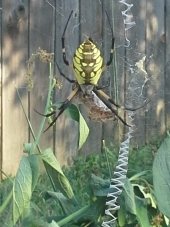I've noted elsewhere on the forum that garter snakes and alligator lizards have given me a slug free garden. Slugs abound in the forest that surrounds my garden. I believe that the snakes have made my largest, sunniest mound their home.
Garter snakes use large communal dens during the winter. They prefer well drained south facing slopes where rocks provide deep shelter well below the frost line. My property runs along the ridge, on the north side of the Nanaimo River. My slopes face south. This is already prime reptile habitat. I plan to improve it further. I have two areas that are really well drained on silty gravel, just above the ridge. These areas would be improved by the addition of some larger rocks. Using the excavator, I'd like to go down 10 ft. The holes could be filled by my abundant supply of rocks. Snakes and lizards both require warm basking areas where they go to heat up before going hunting. Alligator lizards are very sensitive to this requirement. They do well in clear cuts and often abandon areas where trees grow up to shade their basking rocks. I will grow grapes, herbs and other heat lovers near the dens and keep tall trees and bushes cut back.
I hope to make my place an attractive wintering site for all of our reptiles. None pose any danger to humans or livestock. These areas near the crest of the ridge are well outside of where I am putting roads or large buildings. The most secluded area will be designed to accommodate the very shy alligator lizards. Their need for hot basking areas is greater and since they flee whenever they see people or other large creatures, this will give them a better chance to feel safe. Lizards that are constantly disturbed don't feed as often, since they loose heat while hiding deep in their dens. Reproduction rates improve as the habitat improves. All of the species I'm looking to attract are abundant and not threatened. Still, I won't be handling them or bringing any reptiles. They are already here.
I may need to put some space between the snakes and lizards. Garter snakes will eat young lizards. The lizards favor the hot slopes. Garter snakes like the boggy areas and the stream.
The existing hugel beds will be improved with some dark rocks on the south side that adjoins the gravel road. The snakes already bask there. In the morning, when the rocks are still cool, the snakes bask on top of the leaf mulch. With its low thermal mass, it heats up early in the day. Snakes returning to bask in the afternoon are more likely to be found amongst the rocks. I've seen lizards on dark rocks that were too hot for me to sit on. After basking, the lizards are really quick. A deep layer of rock on the hugel's south slope, that holds heat through the night, will allow snakes to warm up earlier in the day and to stay warm into the evening. A snake who remains warm through the night, digests food faster and thus is able to feed more often. This improves growth rates and reproductive success.
Garter snakes are found as far north as Fort Smith in Canada's North West Territory. No other North American snake comes close to this latitude. Their ability to reproduce over a short season is key to their survival. Young are born live. The largest communal dens and the largest congregation of reptiles in the world are found in the southern lakes district of Manitoba Canada. Up to 70,000 red sided garter snakes congregate at the Narcisse Snake Pits, which are large limestone caverns that allow the snakes to go deep into the ground to avoid the harsh winter.
I'd like to have a few hundred snakes. At both ends of the denning season, garter snakes spend a few weeks near the den sites. This allows them to feed and breed (spring) close to the safety of a deep den. They retreat to the den during cold weather and at night, but they surface in the heat of the day. The warm micro climate of my south facing slopes would allow them to stretch their active season a little. Some of my tender fruits will require netting to keep birds of of them. Eagles, hawks, ravens and owls are snake predators. The netting will keep those areas safe. Predatory birds are known to follow snakes movements, so that they can locate others near dens. Some prime basking rocks will be given an overhead net.
Before going very far into this, I'm going to run my plan past some snake experts. My hugelkultur mounds have become great snake habitat. The big one in full sun is only about 150 ft from a cool wet area with some standing water. I suspect that the snakes that bask on the hugel bed are hunting over a wide area and returning when they need to warm up. The beds seem devoid of prey for so many snakes. Not one slug. None.

---------------------------------------------------------------------------------------------------
All of Canada's reptiles are beneficial species that are legally protected. I will therefore not transport or otherwise interfere with these animals. Once established, denning areas will not be excavated again. Any alterations will happen in the summer after the snakes have dispersed. Excavator work on occupied hugel beds will be done in the warm season as well. When I added to the big one a couple weeks back, The snakes all headed for the forest as the machine approached. Usually machine work is preceded by chainsaw work and other activity that causes wildlife to retreat to a safe area. Two hours after 600 sq ft of new bed was given a top dressing of soil, a snake came to investigate. It may have been looking for bugs in the newly disturbed soil, or it may have been interested in the new real estate.

 8
8






















































